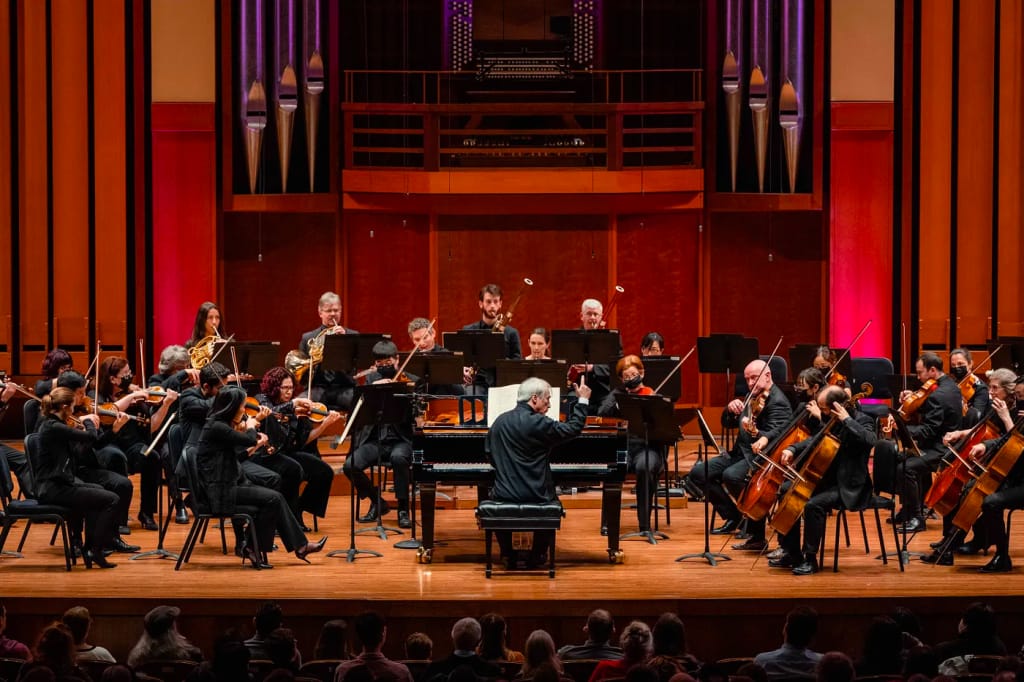- Gathering Note
- Posts
- Classical Period shines in program featuring Haydn, Mozart and Beethoven piano concerti performed by Jean-Efflam Bavouzet and the Seattle Symphony
Classical Period shines in program featuring Haydn, Mozart and Beethoven piano concerti performed by Jean-Efflam Bavouzet and the Seattle Symphony

Jean-Efflam Bavouzet and the Seattle Symphony, photo credit: Brandon Patoc
Originally published at Seen and Heard International
The names Haydn, Mozart, and Beethoven are practically synonymous with Western music’s Classical Period. But while we may be familiar with the usual suspects in their repertoires, the Seattle Symphony’s recent concert program featuring pianist Jean-Efflam Bavouzet promised to be a refreshing take on these masters with a program featuring three of their lesser-known piano concerti.
Bavouzet and the orchestra opened the program with Franz Joseph Haydn’s Piano Concerto in F Major. Audiences don’t hear Haydn’s piano concerti as much as his pieces for violin and cello. Some of this may be a result of their ambiguous origins, but also the simple geniality of the writing which exudes courtly affability. But Bavouzet’s interpretation avoided these pitfalls, instead emphasizing the wit and energy of Haydn’s writing in a performance that felt like a true partnership with the orchestra.
Bavouzet promptly returned to the stage for Beethoven’s second piano concerto. “Officially” composed in 1793, the piece is actually Beethoven’s first piano concerto. He likely began writing it around the time that Mozart composed his Coronation Concerto in 1788. Hewing to the conventions of the day, young Beethoven’s vision for what music could communicate feels trapped by expectations that this eventual revolutionary was not yet ready to dismantle. Bavouzet’s performance of the concerto was a fascinating glimpse into Beethoven’s early years as a composer and a reminder that the Beethoven we know and love today did not sprout fully formed as a transformational composer — Fifth Symphony and “Emperor” Piano Concerto in hand. He was always a work in progress.
This more nuanced view of Beethoven the composer became apparent juxtaposed against Haydn. Like Haydn’s concerto, Beethoven’s first effort pulses with wit and energy — and is more of a partnership between soloist and orchestra, not a heroic manifestation for soloists that the composer’s later concerti were. Yet, the Second Concerto at times hints at this quality, almost like a preview of paradigm-shifts to come. This was most evident in the opening action of the first movement, where Bavouzet’s entrance brims with misdirection, and throughout the second movement, where the piano leads the orchestra in a ruminating and satisfying back-and-forth.
Bavouzet closed the program with Mozart’s “Coronation” Concerto. At one time, this work was among the most popular in the repertory. With an emphasis on distinguishing the solo piano from the orchestra, the concerto was a showcase for Mozart’s own virtuosic abilities. According to academics, this is most evident in the work’s second movement. There, a simple melody dominates, but in the score the composer layers it on top of an equally simple bass line. Here, the thinking goes, is where Mozart would unleash his pianistic genius, adding improvised flourishes that were never written down. Yet even on its own, the melody as written comes across as a profound statement which Bavouzet caressed to maximum effect, bringing a deeper level of emotion and meaning to the music. Mozart generates unexpected anticipation that Bavouzet and the orchestra exploited to great effect. Beethoven and Haydn’s concertos occasionally feel like pieces you wind up and let go. Mozart, on the other hand, takes the listener on a journey.
In the end, the concert was a triumph, and a reminder that even the most familiar works can be made new again with the right interpretation. Jean-Efflam Bavouzet, along with the Seattle Symphony, created a mid-January gem of a concert that will be remembered long after the city’s wet winter nights give way to the chorus of spring.